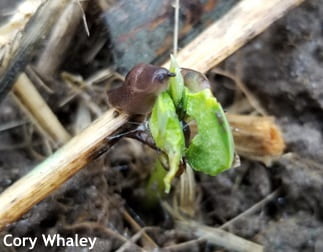David Owens, Extension Entomologist, owensd@udel.edu
Small Grains
We have heard of a few reports of armyworm activity in northern Kent County, with worms clipping barley heads. As we start moving closer to harvest, watch fields that have limited green tissue left for head clipping. Only a couple of products have short pre harvest intervals: Mustang (14 day), and Prevathon (1 day). Good spray penetration with as much water as can be applied by air or a good rate by ground is really important for armyworm; they hide low on the plants, under debris, and at the soil surface during the day and feed from the bottom up. Also, please be aware that Lannate (methomyl) is no longer labeled for small grains in the Mid-Atlantic.
Soybean
This week’s cloudy weather and the few days ahead favor slug activity. If you have a no-till soybean field with high residue, watch your field like a hawk. Soybeans can tolerate some stand loss, but we want to avoid letting a field get to the point that it needs to be replanted due to slug-induced stand loss. Recent tests have shown that the slug baits Deadline and Ferroxx should remain active in fields even with a heavy rain. Please see the WCU article by Phillip Sylvester, Bill Cissel and David Owens titled “Public Enemy Number One: Slugs on Soybeans” from two weeks ago for more slug management information.
I have also run into a large number of ticks when looking at soybean fields, no surprise to most of you I’m sure. According to the CDC, ticks need to be attached 36-48 hours before transmitting disease. Check your pant legs after leaving fields. Keeping a bottle of insect repellent and spraying knees-down will also help.
Bean leaf beetles are active in soybean and seem to be pretty noticeable, probably because there are relatively fewer emerged acres than is normal for this time of year. Grasshopper nymphs are also present in some fields. Last week we posted a diagram of defoliation; once defoliation gets above 20-30% and herbivores are active (2 bean leaf beetles and/or grasshopper nymphs per plant), a spray may be warranted. If defoliation is below this level, keep an eye on it. With warm weather, the soybeans should also quickly outgrow light to moderate leaf feeding.

Four slugs feeding on a cotyledon.
Alfalfa
Continue scouting for potato leaf hopper and hopperburn. Yellowing leaves are a sign that yield has been impacted. New York is reporting their first adult leafhoppers of the season. Thresholds are adjusted for plant height, the smaller the plant, the lower the threshold. As a general guide, use a threshold of 1 leafhopper in 5 sweeps for plants less than 3 inches tall and moving up to 1 leafhopper per sweep for plants greater than 7 inches.
